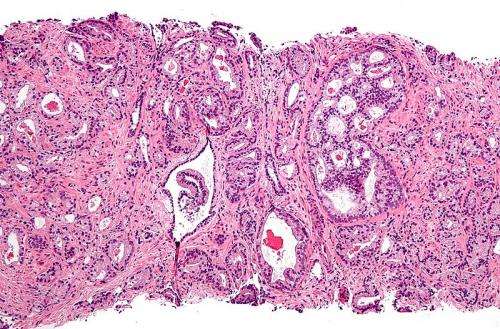Disrupting prostate cancer 'homing signal' could hold promise for new treatments

New King's College London research sheds light on the cellular mechanisms which enable cancer cells to escape the prostate and spread to other parts of the body.
Published today in the journal Oncogene, the findings suggest that it may one day be possible to therapeutically disrupt the 'homing signal' which causes prostate cancer cells to enter the bloodstream and form secondary tumours.
Prostate cancer is the most common cancer in men, with 40,000 new cases a year in the UK. Advanced 'metastatic' prostate cancer develops when cancer cells spread through the blood stream or lymphatic system, where they establish secondary tumours on lymph nodes or bone.
The metastatic form of the disease is currently incurable and despite advances in diagnosis, 30 per cent of men diagnosed with prostate cancer already have metastatic cancer by the time they present at the clinic.
Clinicians are currently unable to predict which prostate tumours will become metastatic and establish secondary tumours in other tissues, and which ones will remain within the prostate. Identifying a molecular pathway that contributes to this process could guide treatment by helping clinicians distinguish between the two forms of cancer, and it could also assist with singling out targets for therapeutic intervention.
A team of scientists and clinicians from King's College London's Institute of Psychiatry, Psychology & Neuroscience (IoPPN) and the University of Oxford examined the cellular machinery of benign and malignant human prostate tissue and human prostate cancer cell lines.
They discovered a molecular pathway that organises the cytoskeleton (a skeletal frame which gives shape to a cell) and enables cells to respond to homing signals and invade other tissue outside the prostate. At the core of this pathway are two proteins called drebrin and EB3, which control the movement of cells through the outer layer of the prostate and into the bloodstream or lymphatic system (a system of thin tubes and lymph nodes that run throughout the body and are an important part of the immune system).
Senior author of the study, Professor Phillip Gordon-Weeks from the Centre for Developmental Neurobiology at the IoPPN, King's College London, said: 'Prostate cancer cells are attracted to the tissue they invade by homing signals released from these tissues. We've now identified the cellular machinery that guides this process and we think these homing signals could one day be disrupted therapeutically to stop cancer cells escaping the primary tumour and invading the body to form secondary tumours.
'This research provides a really compelling example of how basic research can drive and inform translational research. Using animal models, we now need to examine how the prostate cancer homing signal could be manipulated using treatments.'

















